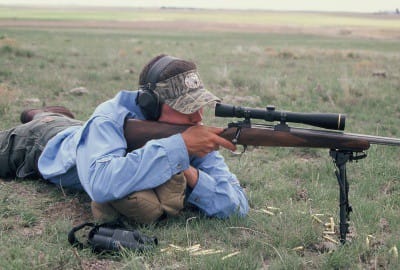
The other day I was chatting with a friend and he ask me one of those questions that really got me thinking, “why should I zero my gun at 100 yards?” This is a great question. Like many things the 100-yard zero has become the accepted distance for zeroing rifles, but why?
Reason number one is theat parallax adjustment is generally set by the scope manufacturers at 100 yards. Parallax is the bending of light rays by the lenses in the scope so the crosshairs really are somewhere other than where they look like they are. The best way to see parallax, which will make it 99 times easier to understand, is to take a pair of safety glasses and hold them at arm’s length and look through them at a corner of a building or door frame that is 10 or 15 feet away. You will see that the edge of the building or door frame is “broken” by the curve of the lens of the glass. As you rotate the glasses slightly on a horizontal axis you will see the “broken” edge magnified. This is parallax.
That said, as long as your eye is behind the scope in exactly the same spot every time you have nothing to worry about. But the way the scopes come adjusted from the factory, when you are 100 yards away from the target, no matter where you move your head the crosshairs stay put. Some rimfire scopes have their parallax adjusted to 50 yards, so make sure and read the instructions that come with your scope.
Reason number two? One hundred yards is far enough that if your scope isn’t properly lined up with the bore of your rifle, it will be very evident and you will most likely run out of windage adjustment before the gun is on target. If this happens, stop what you’re doing and go see a gunsmith.
All that said, 100 yards is the best distance at which to shoot, but not necessarily the best distance to zero your rifle. Let’s say you’re going mule deer hunting in Wyoming and your guide tells you to come prepared to shoot out to 300 yards. Your 7mm-08 is zeroed at 100 yards and at 300 yards you are dropping in the neighborhood of 13 inches. That’s a little too much drop to use the “hold over” method and be precise. What if you zero your gun at 250 yard? The trajectory path at 50 yards is 1.2 inches high, at 100 yards the bullet is 2.9 inches high, at 200 yards 2.3 inches high and at 300 yards the bullet only drops 3.8 inches. Now when you go back to Georgia swamps, you might consider re zeroing at 100 yards for making head shots at shorter ranges.
Long story short, when setting up your rifle and scope, shoot at the distance the scope manufacturer adjusts the parallax to, which is usually 100 yards. But zero the gun to the distance that best suits your hunting situation. A great resource for gaining a better understanding of external ballistics can be found onwww.hornady.com/ballistics. Just start plugging numbers in and running calculations and, in no time, you’ll be able to figure out the most versatile zero for your favorite hunting.







